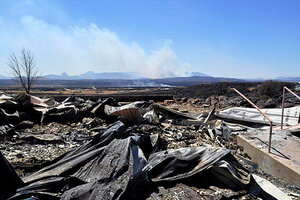Texas wildfires: why this season is one of the worst in state history
Firefighters and smoke jumpers from 25 states have had to turn back hundreds of Texas wildfires. Nearly 100 homes have burned to the ground.

A home destroyed fire is shown as an uncontrolled wildfire burns in the background in Fort Davis, Texas, Sunday, April 10. A fast-moving wildfire had spread to more than 60,000 acres in Presidio County and Jeff Davis County, where it destroyed about 20 homes in Fort Davis.
Billy Marginot/AP
Drought conditions across west Texas are only part of a complex series of weather events that have produced the worst wildfire conditions in Lone Star State history.
Drenching rains from hurricane Alex last July caused a huge plant bloom, which was largely killed off by this year's uncommonly cold winter across the southern US and northern Mexico.
Added to the driest March in state history, those factors set up a massive tinderbox that has exploded with devastating effect, as firefighters and smoke jumpers from 25 states have had to turn back hundreds of aggressive blazes. Nearly 100 homes have burned to the ground, and the fast-moving fires have killed both wild and domesticated animals, including wild boars and horses.
"We're pretty vulnerable right now," says state climatologist John Nielsen-Gammon. "We need rain."
So far, up to 650 blazes have scorched 400 square miles of rolling plains in west Texas, with a massive wildfire in the Mexican state of Coahuila contributing a large smoke plume that has drifted across the border. By comparison, Texas saw 167 wildfire blazes last year.
The total acreage and ferocity of the blazes are now rivaling the 2006 Texas wildfire season, which killed 11 people and destroyed 400 homes, and are shaping up much like the 2000 Western fire season. Back then, the Southwest, including Texas, had 6.5 million acres burn, which was more than double the 10-year wildfire average at the time.
On Monday, the National Weather Service issued "red flag warnings" indicative of "critical fire weather conditions" in Colorado, Kansas, Missouri, New Mexico, Oklahoma, and Texas.
Jeff Davis County in Texas is under a federal emergency as the fast-moving, so-called Rock House wildfire has consumed 80,000 acres, destroying 40 homes in Fort Davis, as it continued to move north and east into the mountains, toward Balmorhea. The scenes have at times been apocalyptic, say residents.
"With it burning across and through the community and across ranch after ranch, all of us are standing around with our jaws dropped," says Revis Daggett, the proprietor of the Wayside Inn Bed & Breakfast in Fort Davis. "You're standing right in the middle of it, and you have no control over it."
The 71,000-acre Swenson fire is 25 percent contained, but it is burning hot through tough terrain and heavy brush toward the town of Benjamin in Knox County.
Authorities now largely control the 16,500-acre Hickman fire in Midland County, but not before it destroyed 34 homes on the south side of Midland.
Forecasts call for a growing chance of thunderstorms in west Texas by the weekend, which could help quell the dozen or so new fires being reported every day.
Unfortunately for Ms. Daggett, news that firefighters were moving closer to containing the fire gave way Monday morning to fresh reports that it had again changed direction, now moving with speed toward the Wayside B&B and surrounding homes.
"Even if they give evacuation orders, forget it, we're staying and fighting," she says in a call to the Monitor.
